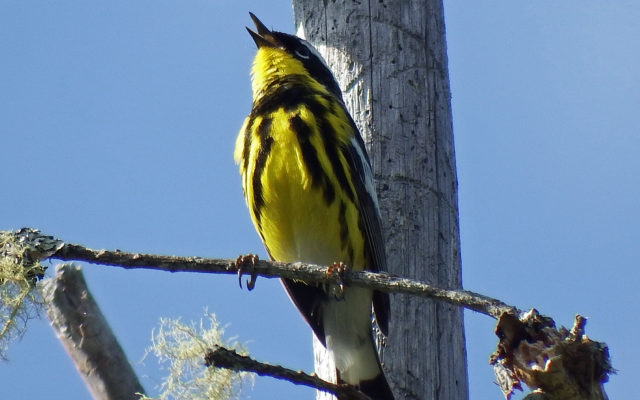
What this birder found while spending five days deep in North Maine Woods
I just spent five days in the North Maine Woods surveying birds for the Maine Bird Atlas during the first week of June. For three of those days, I was so deep in the woods, I did not see another human. I admit, that kind of birding experience is a little extreme for most people. Although I did not come across another person, I did encounter eight bears, seven moose and one surprised Canada lynx. I did it all for science. Yeah, that’s it – for science. Oh, and also because birding the wilder parts of Maine is just wicked good fun.
I have mentioned previously that the Maine Department of Inland Fisheries and Wildlife is in the middle of a five-year project to inventory Maine’s breeding birds. Because birds are noisy, flashy and popular, they are easier to use as a benchmark for assessing long-term environmental changes than, say, weasels. Over the first three years, hundreds of volunteers have fanned out across the state, and they have collectively contributed more than 40,000 bird lists to the database.
Of course, when I say that volunteers have fanned out across the state, I mean across that part of the state where people live. It’s logistically difficult to get volunteers into the nine million acres of Maine’s unorganized territory, where some of the best birding is located. I took that as my personal challenge. I loaded up my camper with great food, acceptable wine and a 6-pack of Baxter Stowaway IPA – my favorite post-birding celebration ale – and inventoried a part of Maine that had likely never seen a birder.
The core three days of my sojourn were centered on Salmon Pond Road, an obscure logging road slightly west of Caribou Lake, just above the Golden Road. It was an ordinary dirt road. There was nothing special about it, except that it’s a bear superhighway. Not only did I keep running into bruins of all sizes, but there was so much bear poop in the road that I had to wipe my feet after each hike.
And there were birds. Lots of them. It’s why getting into Maine’s interior forest can be a visceral experience. On a typical bird walk in the Greater Bangor area, you might hear three or four magnolia warblers. In this one atlas block, I inventoried 42.
Nashville warblers are northern nesters that become common above Bangor. In Bangor City Forest, I usually hear one by the outhouses, another about 300 yards down the road, and another on the Orono Bog Boardwalk. But in my northern forest survey block, I inventoried 24. Yellow-bellied flycatchers are uncommon south of Bangor. But go north? I had 21 in my little block.
However, the true thrill of this total immersion was the chance to sense the rhythm of nature. After a while, you could intuit which birds were still courting, which were nesting and which were actually raising chicks. For instance, all the woodpeckers were eerily silent – a sign that they didn’t want to reveal their nests. They would all drum around sunrise, just to remind their neighbors where their territories were, and then they went quiet the rest of the day.
Red-eyed vireos were abundant and constantly singing. I tallied 32 in the block. Moreover, I saw courtship, with males and females sitting face to face on a branch and vocalizing romantically. I saw one carrying nesting material. But there was no sign of actual nestlings yet.
Ovenbirds are ground-nesting warblers. Males and females are virtually identical. During one walk, I noticed an ovenbird sitting on a nearby branch, just staring at me. I concluded it was a female when another bird began singing just one tree away. If they were both males, a fight would have ensued. Conclusion? They must be a pair. Furthermore, they didn’t have eggs yet because neither scolded me for being so close.
Black-throated green warblers are very common. I counted 20 singing males, and I estimate that none had nests yet. This species does a little “chit-chit” call note that it uses to communicate with mates and fledglings. None were doing that yet.
I saw many robins in the deep woods, including pairs foraging together, but none carrying food. I saw individual blue jays acting furtive, but none carrying food. They were probably nesting but there were no hatchlings yet. Crows were uncharacteristically quiet.
By now, all this has changed. It’s time to go back and count babies.
Duchesne serves as vice president of Maine Audubon’s Penobscot Valley Chapter. He developed the Maine Birding Trail, with information at mainebirdingtrail.com. He can be reached at duchesne@midmaine.com.